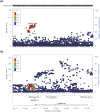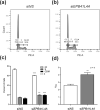Characterizing the function of EPB41L4A in the predisposition to papillary thyroid carcinoma
- PMID: 33203992
- PMCID: PMC7672090
- DOI: 10.1038/s41598-020-76606-0
Characterizing the function of EPB41L4A in the predisposition to papillary thyroid carcinoma
Abstract
Papillary thyroid carcinoma (PTC) is the most common histotype of thyroid carcinoma. The heritability of PTC is high compared to other cancers, but its underlying causes are unknown. A recent genome-wide association study revealed the association of a variant at the 5q22 locus, rs73227498, with PTC predisposition. We report that rs17134155, a variant in high linkage disequilibrium with rs73227498, is located in an enhancer region downstream of coding transcripts of EPB41L4A. Rs17134155 showed significant enhancer activity in luciferase assays, and haplotypes containing the protective allele of this variant conferred a significantly lower risk of PTC. While the index SNP, rs73227498, acted as a significant cis-eQTL for expression of EPB41L4A, rs17134155 was a significant cis-sQTL for the alternative splicing of a non-coding transcript of EPB41L4A, called EPB41L4A-203. We also performed knockdown of EPB41L4A followed by microarray analysis. Some of the top differentially-expressed genes were represented among regulators of the WNT/β-catenin signaling pathway. Our results indicate that an enhancer region at 5q22 regulates the expression and splicing of EPB41L4A transcripts. We also provide evidence that EPB41L4A expression is involved in regulating growth and differentiation pathways, suggesting that decreased expression of EPB41L4A is a mechanism in the predisposition to PTC.
Conflict of interest statement
The authors declare no competing interests.
Figures





Similar articles
-
Multiple functional variants in long-range enhancer elements contribute to the risk of SNP rs965513 in thyroid cancer.Proc Natl Acad Sci U S A. 2015 May 12;112(19):6128-33. doi: 10.1073/pnas.1506255112. Epub 2015 Apr 27. Proc Natl Acad Sci U S A. 2015. PMID: 25918370 Free PMC article.
-
Variants in LRRC34 reveal distinct mechanisms for predisposition to papillary thyroid carcinoma.J Med Genet. 2020 Aug;57(8):519-527. doi: 10.1136/jmedgenet-2019-106554. Epub 2020 Feb 12. J Med Genet. 2020. PMID: 32051256
-
Genetic predisposition to papillary thyroid carcinoma: involvement of FOXE1, TSHR, and a novel lincRNA gene, PTCSC2.J Clin Endocrinol Metab. 2015 Jan;100(1):E164-72. doi: 10.1210/jc.2014-2147. J Clin Endocrinol Metab. 2015. PMID: 25303483 Free PMC article.
-
miR-451a is underexpressed and targets AKT/mTOR pathway in papillary thyroid carcinoma.Oncotarget. 2016 Mar 15;7(11):12731-47. doi: 10.18632/oncotarget.7262. Oncotarget. 2016. PMID: 26871295 Free PMC article. Review.
-
Relationship between genetic alterations and clinicopathological characteristics of papillary thyroid carcinoma.Med Mol Morphol. 2019 Dec;52(4):181-186. doi: 10.1007/s00795-019-00217-6. Epub 2019 Feb 20. Med Mol Morphol. 2019. PMID: 30788603 Review.
Cited by
-
The landscape of GWAS validation; systematic review identifying 309 validated non-coding variants across 130 human diseases.BMC Med Genomics. 2022 Apr 1;15(1):74. doi: 10.1186/s12920-022-01216-w. BMC Med Genomics. 2022. PMID: 35365203 Free PMC article.
References
-
- Noone AM, Howlader N, Krapcho M, Miller D, Brest A, Yu M, Ruhl J, Tatalovich Z, Mariotto A, Lewis DR, Chen HS, Feuer EJ, Cronin KA. SEER Cancer Statistics Review, 1975–2015. Bethesda: National Cancer Institute; 2018.
Publication types
MeSH terms
Substances
Grants and funding
LinkOut - more resources
Full Text Sources
Medical
Molecular Biology Databases

